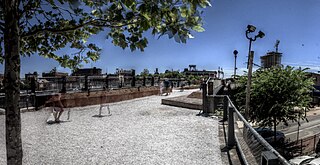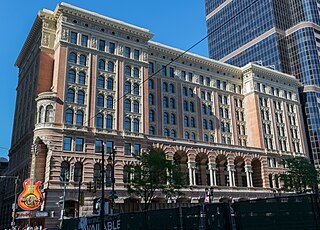
The Southeastern Pennsylvania Transportation Authority (SEPTA) is a regional public transportation authority that operates bus, rapid transit, commuter rail, light rail, and electric trolleybus services for nearly four million people in five counties in and around Philadelphia, Pennsylvania. It also manages projects that maintain, replace and expand its infrastructure, facilities and vehicles.

North Station is a commuter rail and intercity rail terminal station in Boston, Massachusetts. It is served by four MBTA Commuter Rail lines – the Fitchburg Line, Haverhill Line, Lowell Line, and Newburyport/Rockport Line – and the Amtrak Downeaster intercity service. The concourse is located under the TD Garden arena, with the platforms extending north towards drawbridges over the Charles River. The eponymous subway station, served by the Green Line and Orange Line, is connected to the concourse with an underground passageway.

The SEPTA Regional Rail system is a commuter rail network owned by SEPTA and serving the Philadelphia metropolitan area. The system has 13 branches and more than 150 active stations in Philadelphia, Pennsylvania, its suburbs and satellite towns and cities. It is the sixth-busiest commuter railroad in the United States, and the busiest outside of the New York, Chicago, and Boston metropolitan areas. In 2016, the Regional Rail system had an average of 132,000 daily riders and 118,800 daily riders as of 2019.

The Reading Viaduct, also called The Rail Park, is a disused elevated rail line in the Callowhill district of Philadelphia, Pennsylvania, United States that has been partly transformed into a rail trail.

Suburban Station is an art deco office building and underground commuter rail station in Penn Center in Philadelphia. Its official SEPTA address is 16th Street and JFK Boulevard. The station is owned and operated by SEPTA and is one of the three core Center City stations on the SEPTA Regional Rail and one of the busiest stations in the Regional Rail System.

The Center City Commuter Connection (CCCC), commonly referred to as "the commuter tunnel", is a passenger railroad tunnel in Center City Philadelphia, Pennsylvania, The tunnel was built to connect the stub ends of the two separate regional commuter rail systems, which were originally operated by Pennsylvania Railroad and the Reading Company, two rival rail companies.

Forest Hills station is an intermodal transfer station in Boston, Massachusetts. It serves the MBTA rapid transit Orange Line and three MBTA Commuter Rail lines and is a major terminus for MBTA bus routes. It is located in Forest Hills, in the southern part of the Jamaica Plain neighborhood. Most Providence/Stoughton Line and Franklin/Foxboro Line trains, and all Amtrak Northeast Corridor trains, pass through the station without stopping. Forest Hills station is fully accessible on all modes.

The Pennsylvania Convention Center is a multi-use public facility in the Market East section of Philadelphia, Pennsylvania, designed to accommodate conventions, exhibitions, conferences and other events. The L-shaped complex occupies four city blocks.

Jefferson Station is an underground SEPTA Regional Rail station located on Market Street in Philadelphia, Pennsylvania. It is the easternmost of the three Center City stations of the SEPTA Regional Rail system and is part of the Center City Commuter Connection, which connects the former Penn Central commuter lines with the former Reading Company commuter lines. In 2014, the station saw approximately 26,000 passengers every weekday.

Broad Street Station at Broad & Market streets was the primary passenger terminal for the Pennsylvania Railroad (PRR) in Philadelphia from early December 1881 to the 1950s. Located directly west of Philadelphia City Hall, the site is now occupied by the northwest section of Dilworth Park and the office towers of Penn Center.

The Reading Terminal is a complex of buildings that includes the former Reading Company main station located in the Market East section of Center City in Philadelphia, Pennsylvania, United States. It comprises the Reading Terminal Headhouse, Trainshed, and Market.

Wayne Junction station is a SEPTA Regional Rail junction station located at 4481 Wayne Avenue, extending along Windrim Avenue to Germantown Avenue. The station is located in the Nicetown neighborhood of Philadelphia. Wayne Junction serves as a multi-modal transfer point between six of SEPTA's regional rail lines as well as three major transit routes – the Route 75 Trackless Trolley and the Route 23 and 53 bus lines. The station served more than 321,000 riders annually in 2018.

The Causeway Street elevated was an elevated section of the MBTA Green Line light rail system in Boston, located in the area near North Station. It was in operation from 1912 until 2004, when it was replaced with a new tunnel and underground station on a slightly different alignment.

Wilson Brothers & Company was a prominent Victorian-era architecture and engineering firm based in Philadelphia, Pennsylvania. The company was regarded for its structural expertise.

The Chestnut Hill East Line is a route of the SEPTA Regional Rail system. The route serves the northwestern section of Philadelphia with service to Germantown, Mount Airy, and Chestnut Hill. It is one of two lines that serve Chestnut Hill, the other one being the Chestnut Hill West Line. The line is fully grade-separated.

Bethlehem Union Station is a former train station located in the South Side neighborhood of Bethlehem, Pennsylvania. It was built in 1924 by the Lehigh Valley Railroad and the Reading Company, replacing an earlier station built in 1867. Passenger service to Philadelphia on the SEPTA Regional Rail Bethlehem Line lasted until 1981. The station was renovated in 2002 and used for medical clinics beginning in 2003. It is owned by St. Luke's Hospital.

The Philadelphia, Germantown and Norristown Railroad (PG&N) was a railway company in the United States. It was incorporated in 1831 and opened its first line in 1832, making it one of the oldest railroads in North America. The Philadelphia and Reading Railroad, a forerunner of the Reading Company, leased the company's lines in 1870, ending its period of independent operation. Its lines are currently part of the SEPTA Regional Rail network in the Philadelphia region.

The Ninth Street Branch was an elevated railway line in Philadelphia, Pennsylvania. It was operated by the Reading Company; ownership was split between the Reading and its subsidiary the Philadelphia, Germantown and Norristown Railroad. It was a four-tracked main line beginning at the Reading Terminal, the Reading's terminus in Philadelphia, and extending north into the city to a junction with the Bethlehem Branch. After the final bankruptcy of the Reading the line passed to Conrail and later SEPTA. The portion south of the Temple University station was abandoned in 1984 with the opening of the Center City Commuter Connection and is now known as the Reading Viaduct; the portion north is now part of the SEPTA Main Line.

The Norristown Branch is a railway line in Pennsylvania. It runs 14.6 miles (23.5 km) from a junction with the SEPTA Main Line in North Philadelphia to Norristown, Pennsylvania. It was originally built by the Philadelphia, Germantown and Norristown Railroad (PG&N) in 1834, and was a part of the Reading Company system from 1870 until 1976. Today it is owned by SEPTA and hosts the Manayunk/Norristown Line commuter rail service.
The Chestnut Hill East Branch is a railway line in Pennsylvania. It runs 5.5 miles (8.9 km) from a junction with the SEPTA Main Line in Nicetown–Tioga, a neighborhood in Philadelphia, to Chestnut Hill, Philadelphia. The oldest part of it was built in 1832 by the Philadelphia, Germantown and Norristown Railroad. It was part of the Reading Company system from 1870 until 1976. Today it is owned by SEPTA and hosts the Chestnut Hill East Line commuter rail service. The line runs roughly parallel to the Chestnut Hill West Branch, formerly of the Pennsylvania Railroad.




















